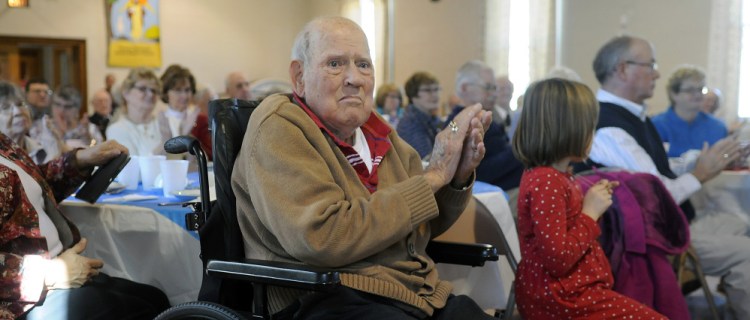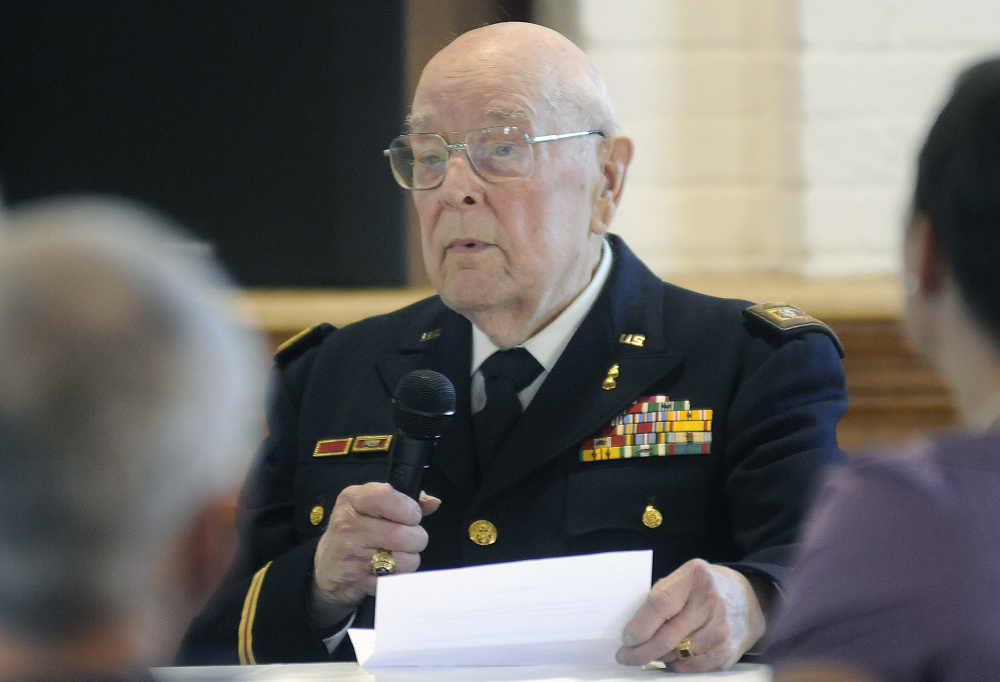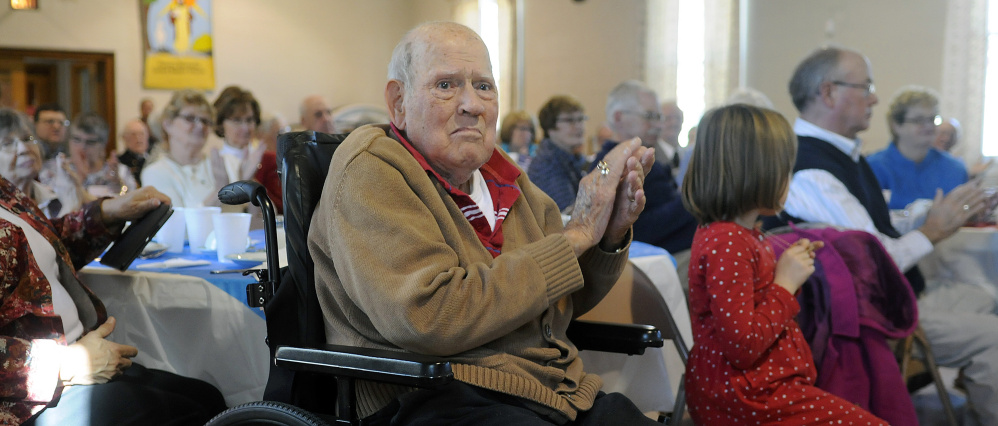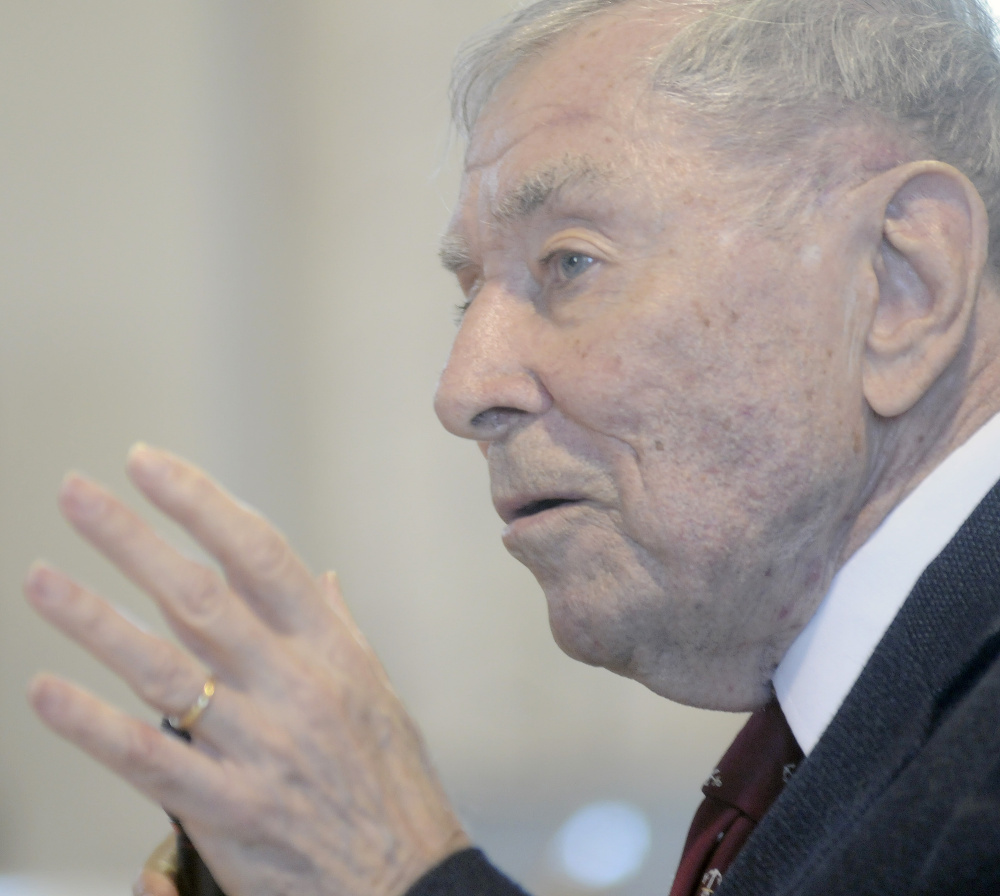AUGUSTA — John Moulis was, in a sense, like any high school senior, wondering what awaited him on the other side of graduation.
But the dreams of grandeur most seniors are allowed were never an option for Moulis and millions of others like him who came of age during World War II. The questions of wealth and family were replaced by uncertainties and the legitimate understanding that life itself has no guarantee.
“The whole world was at war, and the allies were not winning,” Moulis said. “What was the point of considering college or a career? The lives of the class of 1943 were on hold.”
Moulis was one of three World War II veterans who shared their stories with a couple hundred people who gathered Sunday for Penney Memorial Baptist Church’s Veterans Day Potluck. The three men, who also include Les Hann and Ivan LaBree, are all members of the church off Memorial Circle and are part of the more than 16 million Americans who fought in the war.
The experiences of the three men provided a snapshot of life on every front of the war. Army veteran Hann made the landing on D Day in June 1944 and fought his way to Germany. Navy veteran LaBree served on a ship in the Pacific and had a ship side view of the Sept. 2, 1945, surrender on the USS Missouri in Tokyo Bay that brought the war to an end. Moulis served the U.S. Navy as a postmaster for the Armed Guard in New York.
“When I see a veteran I say, ‘Thank you for your service,'” said Gary Crocker, who helped organize the event. “When I see a World War II veteran I say, ‘Thank you for saving the world.’ They did nothing less than save the world.”
Crocker spoke for his friend, Hann, who provided a brief biographical sketch of his experiences during the war. That experience includes the infamous Battle of the Bulge, the German surprise attack in December 1944 in Belgium that killed 19,000 Americans.
“At night the Germans would slip in to try to cut the throats of our troops,” Crocker read.
Hann’s account was punctuated by humorous understatements, like his description of crawling under live fire used during his training.
“One man saw a snake and jumped up and was hit,” Crocker read. “I’m glad I didn’t see a snake.”
But the humor proved little cover for the difficulty, danger and fear Hann experienced almost unceasingly. After training he was shipped to Europe and hit a storm that created 60-foot waves that spared his ship but sank another. His time in combat was peppered by close calls, like the time he found out he was getting a leave to go home. Hann was so excited he went outside the village to relieve himself moments before a bomb exploded right where he had been standing. There were even times in the confusion of war that Hann was shot at and bombed by allied forces.
“Les talks about his luck and God looking for him throughout,” Crocker said. “This man made his way across Europe one fight a time.”
Moulis’ war effort carried him to New York where his experience helping out in his town’s post office during high school was put to use delivering mail for the Navy.
“I was spared a lot of the wartime sacrifices that many of my friends had to go through,” Moulis said.
He was 14 when the war started in September 1939. The second World War was viewed as a continuation of the first.
“The sons picked up the guns the fathers laid down 20 years earlier,” Moulis said.
The United States would not enter the fray for another two years, but Moulis recalled the difficult life here.
“There were prayers for those in uniform and for our country,” Moulis said, his voice thick with emotion. “It looked more and more like we would be drawn into that war.”
Life at home only got more difficult when the U.S. went to war. Every man not working in an industry that supported the war effort, or who was not otherwise disqualified, was required to serve. Young men were not the only scarcity. Goods were rationed so that Moulis’ family didn’t even bother to register their car for three years because there was no gasoline. High school students were taught how to march and children went to elementary school with pennies to donate to defense.
“I’ve never seen our country so unified,” Moulis said. “We looked for ways to support our fathers, our brothers and our neighbors who were off to war.”
By the time he graduated in 1943, Moulis’ yearbook had a page reserved for the 68 members of the senior class who were already serving and another page reserved for the 16 teachers who joined them.
Moulis grew up in a church whose pastor, Rev. William Turner, was killed after signing up for the chaplaincy. Losing the beloved man stirred fervent prayers and letters from the church members, prayers and letters that Moulis said helped sustain him throughout his service.
“I discovered during those years that God’s people can be found everywhere,” Moulis said.
LaBree, too, recalled the early days of the war when there was great uncertainty whether America, or the rest of the world for that matter, would be able to keep from falling under the punishing rule of Germany or Japan.
“It didn’t look good in Europe,” LaBree said. “Everyone knew the Germans were heading for England and (Japanese Emperor) Hirohito owned the Pacific.”
Everything, including soldiers, were in short supply, so the government lowered the draft age from 21 to 18 as LaBree was going into his senior year in 1944.
“Most of us wanted to keep away from being drafted in the army,” he said.
He signed up for the Navy under a program that he was assured would allow him to finish high school.
“The government doesn’t always tell the truth,” LaBree said with a chuckle.
He was sent to boot camp a couple of months before graduation. Half of his boot camp class was sent for training to serve on a heavy cruiser. The reality of what they faced hit the crewmen the morning they were to leave when their departure was delayed so that a damaged cruiser could be taken into port. LaBree still recalls the hole blown through the side of the hull.
“We thought, holy mackerel, what are we getting into?” LaBree said.
The cruiser was assigned to be part of a massive bombing campaign against mainland Japan in advance of an anticipated ground attack that some officials estimated would kill a half million Americans. Early one afternoon in August 1945, LaBree’s ship was given orders to stop the bombing and head out to sea. Nobody knew why.
“After a couple of days, we got word that a bomb had been dropped on Hiroshima,” LaBree said.
Hirohito agreed to surrender a few days later when another atomic bomb was dropped on Nagasaki. More than 120,000 people died the first day of the bombings and thousands of others later on from the effects of radiation.
LaBree, who was sent to Nagasaki to help look for survivors and make an assessment, showed pictures of the bombed out city. The only buildings standing are storage shelters that had been reinforced with steel and concrete.
“It disintegrated,” LaBree said.
He did not set foot on U.S. soil again until May 1946. The war, over for more than seven months, was already beginning to fade from people’s memories. LaBree left the Navy a month later, though he would go on to serve in the U.S. Army.
“I was discharged in June 1946. I got home and I’m a veteran,” LaBree said. “That’s the end of my story.”
Craig Crosby — 621-5642
Twitter: @CraigCrosby4
Copy the Story LinkSend questions/comments to the editors.






Success. Please wait for the page to reload. If the page does not reload within 5 seconds, please refresh the page.
Enter your email and password to access comments.
Hi, to comment on stories you must . This profile is in addition to your subscription and website login.
Already have a commenting profile? .
Invalid username/password.
Please check your email to confirm and complete your registration.
Only subscribers are eligible to post comments. Please subscribe or login first for digital access. Here’s why.
Use the form below to reset your password. When you've submitted your account email, we will send an email with a reset code.